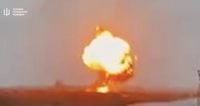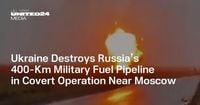In a dramatic escalation of its campaign to cripple Russia’s military logistics, Ukraine’s military intelligence service announced it had struck and disabled a major fuel pipeline near Moscow on the evening of October 31, 2025. The operation, confirmed by both Ukrainian and Russian sources, targeted the Koltsevoy (Ring) pipeline—a 400-kilometer (250-mile) artery that supplied the Russian army with gasoline, diesel, and jet fuel from several key refineries. Ukrainian officials hailed the attack as a devastating blow to Russia’s war machine, boasting that the impact of their strikes has exceeded that of international sanctions.
According to the Associated Press, Ukraine’s Main Directorate of Intelligence (HUR) claimed responsibility for the precision strike on infrastructure near the Ramensky district, southeast of Moscow. The Koltsevoy pipeline, which had been protected by anti-drone defenses and armed security, was left inoperable after all three major fuel lines exploded simultaneously. The pipeline’s annual capacity was staggering: up to 3 million tons of jet fuel, 2.8 million tons of diesel, and 1.6 million tons of gasoline, according to HUR’s statement.
“Our strikes have had more impact than sanctions,” Kyrylo Budanov, the head of Ukraine’s military intelligence, declared on Telegram, as reported by the Kyiv Independent and New York Post. “It’s just a mathematical truth. We caused much greater damage to the Russian Federation through direct action than any economic levers of influence that had been introduced on them until now.” Budanov’s remarks underscore Ukraine’s belief that targeting critical infrastructure is a more effective means of hampering Russia’s military efforts than relying solely on economic pressure from the West.
The Koltsevoy pipeline, sometimes referred to as the “Ring” pipeline, was a critical logistical link for the Russian armed forces, connecting refineries in Ryazan, Nizhny Novgorod, and Moscow to military storage facilities and front-line units. Despite the presence of anti-drone nets and security personnel, the Ukrainian strike managed to destroy all three lines simultaneously, rendering the system inoperable. The Kyiv Independent described the attack as a “serious blow” to Russia’s military logistics and its economy, particularly in the Moscow region.
Security Service of Ukraine chief Vasyl Maliuk added further context at a press briefing in Kyiv, stating, “Oil extraction and refining make up around 90% of Russia’s defense budget. These are the dirty petro-rubles funding the war against us. These are legitimate military targets.” According to Maliuk, Russia’s domestic fuel shortage is nearing 20%, a crisis that has forced Moscow to ban exports of refined oil products until the end of the year. This self-imposed embargo highlights the growing strain on Russia’s energy sector as a direct result of Ukrainian sabotage operations.
The pipeline attack was part of a broader Ukrainian drone assault on Russian territory overnight. Russia’s Defense Ministry reported intercepting 98 Ukrainian drones across 10 regions, including 11 over Moscow Oblast, according to Meduza. Six of these drones were reportedly headed toward the capital itself. In the city of Zhukovsky, located about 40 kilometers southeast of Moscow, local authorities reported a rare large-scale power outage overnight, attributing the blackout to an “automatic equipment shutdown.” Meanwhile, in Tula, drone debris fell onto city streets, prompting officials to restrict traffic.
These coordinated strikes reflect Ukraine’s broader strategy of dismantling Russia’s military infrastructure and undermining its ability to sustain the war effort. The Kyiv Independent emphasized that the disabling of the Koltsevoy pipeline is just the latest in a series of precision attacks on Russian logistics, which have included previous covert operations against strategic missile systems and other high-value targets. HUR chief Budanov has repeatedly argued that such operations inflict greater losses on the Kremlin’s war machine than any international sanctions regime.
As Ukraine ramps up its sabotage campaign, the ground war in eastern Ukraine remains fiercely contested. On November 2, Russia’s Defense Ministry claimed it had defeated a Ukrainian special forces team in the front-line city of Pokrovsk, a key stronghold in the embattled Donetsk region. Videos posted by the Russian ministry purportedly show two Ukrainian soldiers who surrendered in the city, but the authenticity of these videos could not be independently verified. Ukrainian officials, meanwhile, offered a different account. Army chief Oleksandr Syrskyi described the situation in Pokrovsk as “hardest” for Ukrainian forces but insisted there was “no encirclement or blockade as Moscow has maintained.”
Ukrainian President Volodymyr Zelenskyy acknowledged that some Russian units had infiltrated Pokrovsk, but stated, “There are Russians in Pokrovsk. They are being destroyed, gradually destroyed, because, well, we need to preserve our personnel.” He stressed that Ukrainian forces are conducting a comprehensive operation to push Russian troops out of the city, with the main burden falling on UAV operators and assault units. The Institute for the Study of War estimates that Russia currently occupies 99% of Luhansk and 72% of Donetsk. If Pokrovsk were to fall, it would be the largest city captured by Russian forces in more than two years of fighting.
Elsewhere in Ukraine, the violence continued unabated. On November 2, a Russian Iskander ballistic missile strike killed one civilian and wounded 19 others, including a 9-year-old girl, in the southern Mykolaiv region, according to local official Vitaliy Kim. Another Russian strike sparked a fire at a gas plant in the central Poltava region, while in the northern Chernihiv region, an agricultural enterprise was hit, injuring a 66-year-old woman. These attacks are part of what Kyiv has described as a “systematic energy terror” campaign, targeting Ukraine’s energy infrastructure and causing widespread power outages across the country.
In response, Ukraine’s air force reported shooting down 206 out of 223 Russian drones launched overnight into November 2, with 17 drones striking targets in seven Ukrainian regions. The scale and intensity of these attacks highlight the technological arms race between the two countries, with each side seeking to outmaneuver the other’s defenses and inflict maximum damage on critical infrastructure.
As winter approaches, the destruction of the Koltsevoy pipeline and the ongoing tit-for-tat strikes on energy facilities underscore the high stakes of the conflict. Both sides are racing to disrupt each other’s supply chains, sap morale, and gain the upper hand—on the battlefield and beyond. For now, Ukraine’s bold strike near Moscow has sent a clear message: the war’s front lines are no longer limited to the trenches of Donbas, but now stretch deep into the heart of Russia’s own logistical network.






